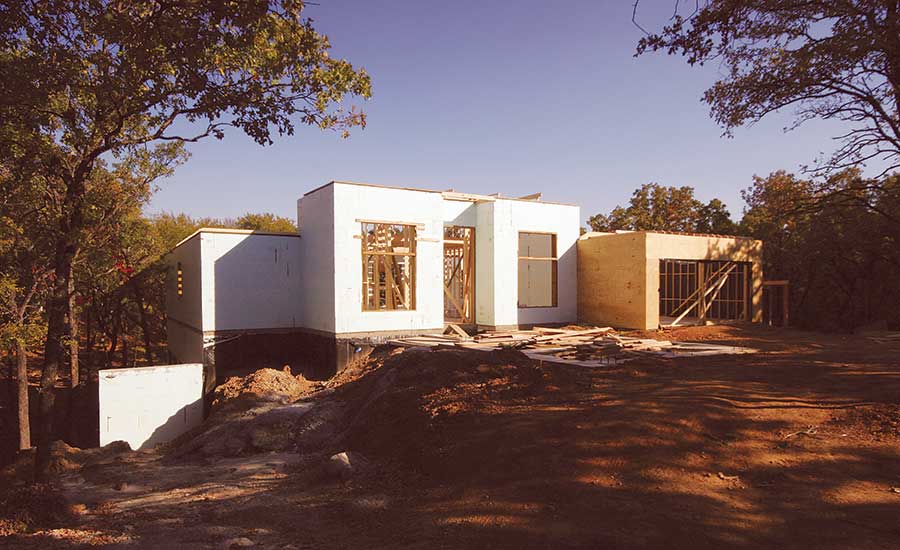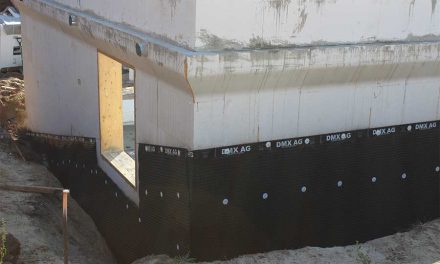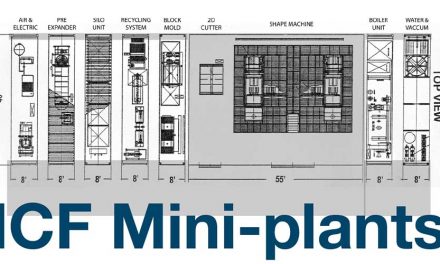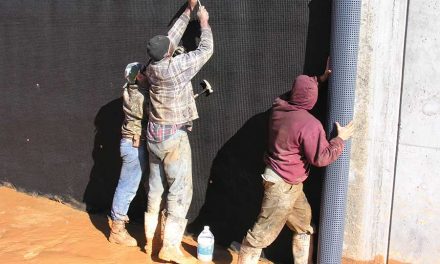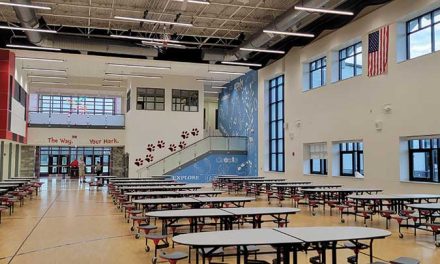Gary Ivy’s 6,000 sq. ft. custom home in Ft. Worth, Texas, is built entirely from ICFs, including the indoor swimming pool, wine cellar, and tornado-proof safe room.
From rooftops to walk-out basements, Insulating Concrete Forms are being used in uncommon resi-
dential applications.
In North Texas, two separate homeowner-builders are demonstrating the versatility of ICFs, using them to construct features that are usually built with other materials. These homebuilders represent a growing number of residential construction experts who are blazing trails with unusual ICF treatments.
Take Larry Smith’s new home. He tore down his existing bungalow, built in a tree-filled, 50-year-old neighborhood in Arlington, Texas, and is starting over with a new 4,000-square-foot ICF dream home. Smith, a 58-year-old retired commercial and residential remodeling contractor, is serving as general contractor, and has loaded the house with special features for himself and his wife, Rita.
The decision to tear down and start over was easy for Smith, who says the small, wood-framed house he and Rita had lived in for 27 years was an “energy nightmare.”
Doing research on the internet and at trade shows, he concluded that ICF construction was the wave of the future, settling on NUDURA ICFs, because the strength of the forms, the fact that they are reversible and come in a variety of sizes.
Nestled among large oak trees on a ¾-acre lot, Smith’s single-story house features 3,000-square feet of living space and an attached 1,000-square-foot garage. The Smiths enjoy the outdoors, so the home has three attached porches and—the most unusual feature of the structure–a 4,000-square-foot deck on top of the house.
Smith concluded that a conventional roof on such a large house would be extremely tall and encroach on the trees that overhang the home. Not willing to sacrifice a single tree, Smith elected to create a flat concrete roof. He chose to use ICF construction for the roof as well.
The exterior stucco walls of the home extend two feet above the roof to create parapet walls. The walls at the front of the house extend up to 16-feet high, adding an extra dimension of comfort.
Smith describes the deck as more than just a big rectangle. Because the exterior of the home has 22 corners, this large rooftop space has an interesting shape. Smith is looking forward to creating patio niches and play areas on his deck.
Smith used ICFs on a long interior wall to help support the roof, but its mass will also help regulate interior temperatures. Smith chuckles that this ICF wall is conveniently situated between the master bedroom area and the large “grandkids” retreat, an added soundproofing bonus.
Additionally, Smith has built an 8-foot-square ICF “safe room”. Most of the time, this room will serve as storage for heirlooms and valuable papers, but when tornado sirens sound in the area, Smith expects it will be a gathering place for family and neighbors to weather out the storm.
One of the most ambitious aspects of the project was Smith’s decision to do the entire pour—walls and roof—in a single day. The pump truck was set up by 3:50 a.m. and the pouring began at 4:15 a.m. When the job was completed at 2 p.m., 17 trucks had poured a total of 170 cubic yards.
Smith has become something of an evangelist for ICF construction. His project has appeared in the local newspaper and on a show produced by a meteorologist in Fort Worth. In addition, neighbors and others who happen by are certain to hear Smith’s praise of the technology. One of his favorite bragging points is the certified engineering report that guarantees heating and cooling cost of $95 a month maximum at the current rates. That, says Smith, is a 60% savings over similarly-sized wood-framed.
He expects to recoup the additional 5 percent he spent to build the home in utility costs within 2 to 5 years, depending on energy costs. Those prices, as he likes to point out, “are only going up.”
Just five miles to the west in Fort Worth, Gary Ivy is building a large ICF home with plenty of custom features. The 6,000 sq. ft. stone and stucco house sits on just over an acre, surrounded by native trees and filled with natural light and pleasant views.
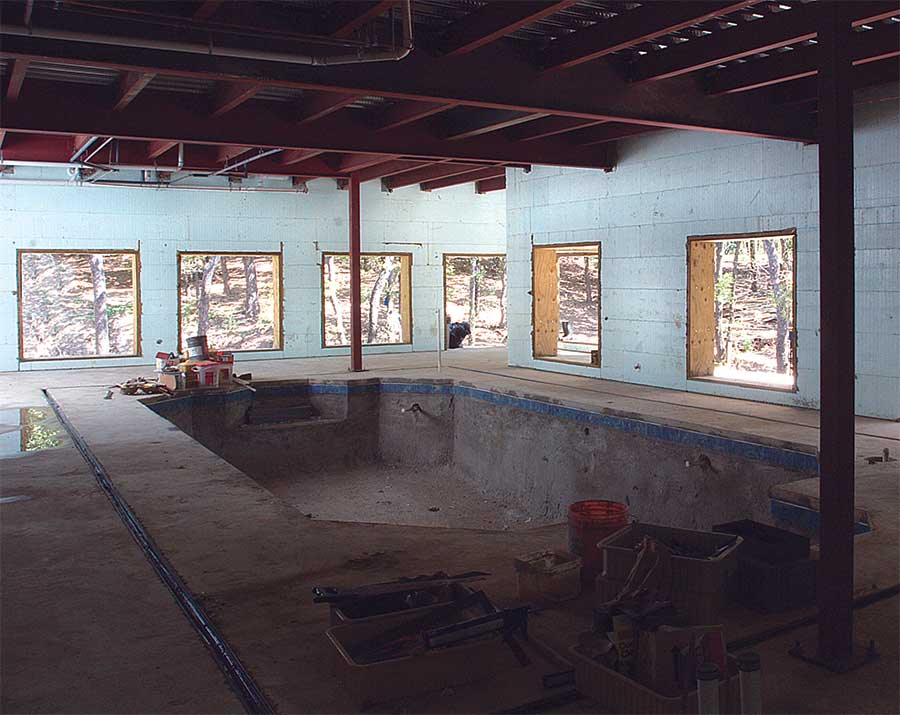
Despite being enclosed with 17-in-thick concrete walls, this basement remains light and inviting thanks to 7 large windows and 3 glass doors.
The most unusual aspect of the house is the huge, 3,000 sq. ft. walk-out basement. Built into a sloping hill, two sides are underground, while two are above ground. To meet load requirements, the basement walls—including foam—are 17 inches thick. Offsetting these heavy walls is plenty of natural light coming through seven large windows, a sliding glass door and two French doors.
The large rectangular basement was built for fun. It houses a 15-foot by 35-foot swimming pool, a wet bar, shuffleboard area and pool table.
A wine cellar, surrounded by 12-inch ICF walls, will serve as a safe room during tornado warnings.
This is Ivy’s first ICF home. One of the main selling points of this house is its energy efficiency. He wanted to make this house as energy-efficient as possible, and has succeeded; his certified engineering report estimates average heating and cooling costs to be $158 a month.
Ivy, who constructed the ICF walls with three workers, says, “the ICF part of this project was the easiest part.”
Just like Smith, Ivy has become something of a spokesperson for ICF construction. “Everyone who drives by wants to come inside,” he says.
Two builders, two homes, one solution: ICFs. By showcasing interesting treatments in their own homes, builders such as Smith and Ivy are living testimonials to the versatility of ICF technology for use in residential construction.
Randy McGuffee is vice president of FutureStone LLC, a Texas-based ICF distributor . He can be reached via phone 817-377-9215 or by email at randy.mcguffee@futurestone.com.

